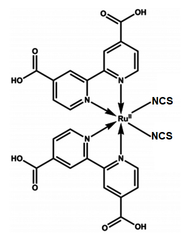A ruthenium complex
used as a dye high performance DSSCs
Specifications | MSDS | Literature and Reviews
Cis-bis(isothiocyanato)bis(2,2′-bipyridyl-4,4′-dicarboxylato)ruthenium(II), also known as N3 Dye, is one of the earliest benchmarked ruthenium complex dyes developed for high-efficiency dye-sensitized solar cells (DSSC). Since its discovery, it has become the paradigm of heterogeneous charge-transfer sensitizer for mesoporous solar cells.
Fully-protonated N3 dye has absorption maxima at 518 nm and 380 nm, with extinction coefficients of 13 K and 13.3 K M−1 cm−1 respectively. Adsorbed onto nanocrystalline TiO2 film, total energy conversion efficiency from light to electricity η of the cell was 10% under AM 1.5 irradiation [1]
Ruthenium bipyridine complex
A high performance dyes used in DSSCs
Worldwide shipping
Quick and reliable shipping
Amphiphilic and stable
increased electrostatic binding to TiO2 and oxidation potential
High purity
>99%
General Information
| Full name | Cis-bis(isothiocyanato)bis(2,2′-bipyridyl-4,4′-dicarboxylato)ruthenium(II) |
| Synonyms | N3 Foundation Dye |
| Chemical formula | C26H16N6O8RuS2 |
| Molecular weight | 705.64 |
| CAS number | 141460-19-7 |
| HOMO / LUMO | HOMO = -5.39 eV, LUMO = -2.79 eV |
| Solubility | Ethanol |
| Classification / Family | Transition metal complex, Ruthenium complex, Bipyridyl ligands, Energy materials, Dye-sensitized solar cells DSSC) materials, Donor materials, OPV materials. |

Product Details
| Purity | 99% |
| Melting point | >300 °C |
| Appearance | Dark purple powder |
MSDS Documentation
Literature and Reviews
- Conversion of light to electricity by cis-X2bis(2,2'-bipyridyl-4,4'-dicarboxylate)ruthenium(II) charge-transfer sensitizers (X = Cl-, Br-, I-, CN-, and SCN-) on nanocrystalline titanium dioxide electrodes, M. K. Nazeeruddin et al., J. Am. Chem. Soc., 115 (14), 6382–6390 (1993); DOI: 10.1021/ja00067a063.
- Monitoring N3 Dye Adsorption and Desorption on TiO2 Surfaces: A Combined QCM-D and XPS Study, H. K. Wayment-Steele et al., CS Appl. Mater. Interfaces, 6 (12), 9093–9099 (2014); DOI: 10.1021/am500920w.
- Aggregation of ZnO Nanocrystallites for High Conversion Efficiency in Dye-Sensitized Solar Cells, Q. Zhang et al., Angew. Chem., 120, 2436 –2440 (2008); DOI: 10.1002/ange.200704919.
